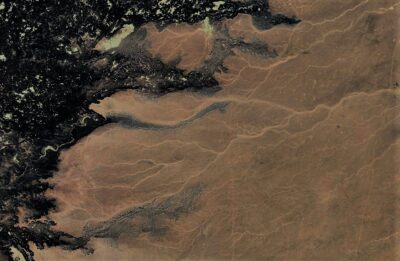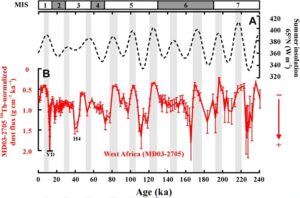
André Bijkerk
As we in the north of the globe wonder about climate changes in the past, we think about ice ages, the equatorials however wonder about climate change as in monsoons changes. For instance if we zoom in on the Sahara in Google Earth we see remains of lush rainforests and numerous rivers in various shades of tan, leaving no doubt that the Sahara had quite a different climate once. Obviously the question is when and why.

Fig 1 Sahara from 72 KM Altitude. Credit Google, CNES Airbus Digital Globe Permission https://www.google.com/permissions/geoguidelines/
When the Sahara is desert like it is now, it produces large dust storms over the Atlantic due to predominant north easterly trade winds and monsoons and DeMenocal[1] investigated marine sediments off the coast of Mauretania on several records, including influx of dust, They confined such a humid period between 14.8 and 5.5 thousand years ago. It was attributed it to a strengthening of the African Monsoon due to changes in insolation as a result of the Milankovitsch cycle. It was also noted that the period of the Younger Dryas was recognized as an dry/arid intermezzo. We will come to that in a next blog. Also it was noted that the swings in climate were very rapid, pertaining mere decades.
Recently researchers at MIT did similar research on a sediment core covering the last 240,000 years and discovered that these climate swings between moist and arid seem to occur about every 20.000 years. Publication here.

Fig 2 (Original fig 4B Skonieczny C, et al 2019) comparing dust influx with insolation
The main Milankovitch cycles are a complex of 413, 125, 95 thousand years for the eccentricity of the Earth’s orbit, then 41 thousand years for the axial tilt (obliquity) and 23 thousand years for precession. It is assessed that the pace of the Sahara humidity regime is depending on the precession cycle. The latter, in combination with eccentricity causes the sun to be furthest away during the Northern hemisphere summer half a precession cycle, 11,5 thousand years, ago the sun was closest to the Earth during the northern hemisphere summer, intensifying insolation and modifying monsoon cycles.
Also their work fig 2 suggest rapid changes See fig 2 Original fig 4B, It’s also noted that the African Humid periods are not closely associated with the ice age cycles which appear to be in 100 thousand year cycles. More about that too later.
Finally,
this African dry-moist flipflop could give grounds for the speculation that it’s the direct cause of the ‘out of Africa’ tendency. Mammoths presumably came out of Africa and lots of other “Afrotheria” ; even humans. Consequently it could be that the moist periods provided an excellent biotope to thrive and devellop for countless species and then the following dry period caused the biotope to collapse, forcing its members to either migrate elsewhere or perish.
Original study: Skonieczny C, et al 2019, Monsoon-driven Saharan dust variability over the past 240,000 years. Science Advances 02 Jan 2019: Vol. 5, no. 1, eaav1887; DOI: 10.1126/sciadv.aav1887
[1] DeMenocal P, et al 2000, Abrupt onset and termination of the African Humid Period:: rapid climate responses to gradual insolation forcing. Quaternary Science Reviews Volume 19, Issues 1–5, 1 January 2000, Pages 347-361
Update: final paragraph added

Dear André, What about the effects of dust on percipation, cloudforming and cloud collour at its top and bottom ? what is known about this?
Dear Frans,
Obviously dust should have concequences for the weather, however records from the past are not detailed enough to shed a light on that. The arid moist swings are just a conclusion based on the stratification of deposits in the ocean, lakes and ice cores.